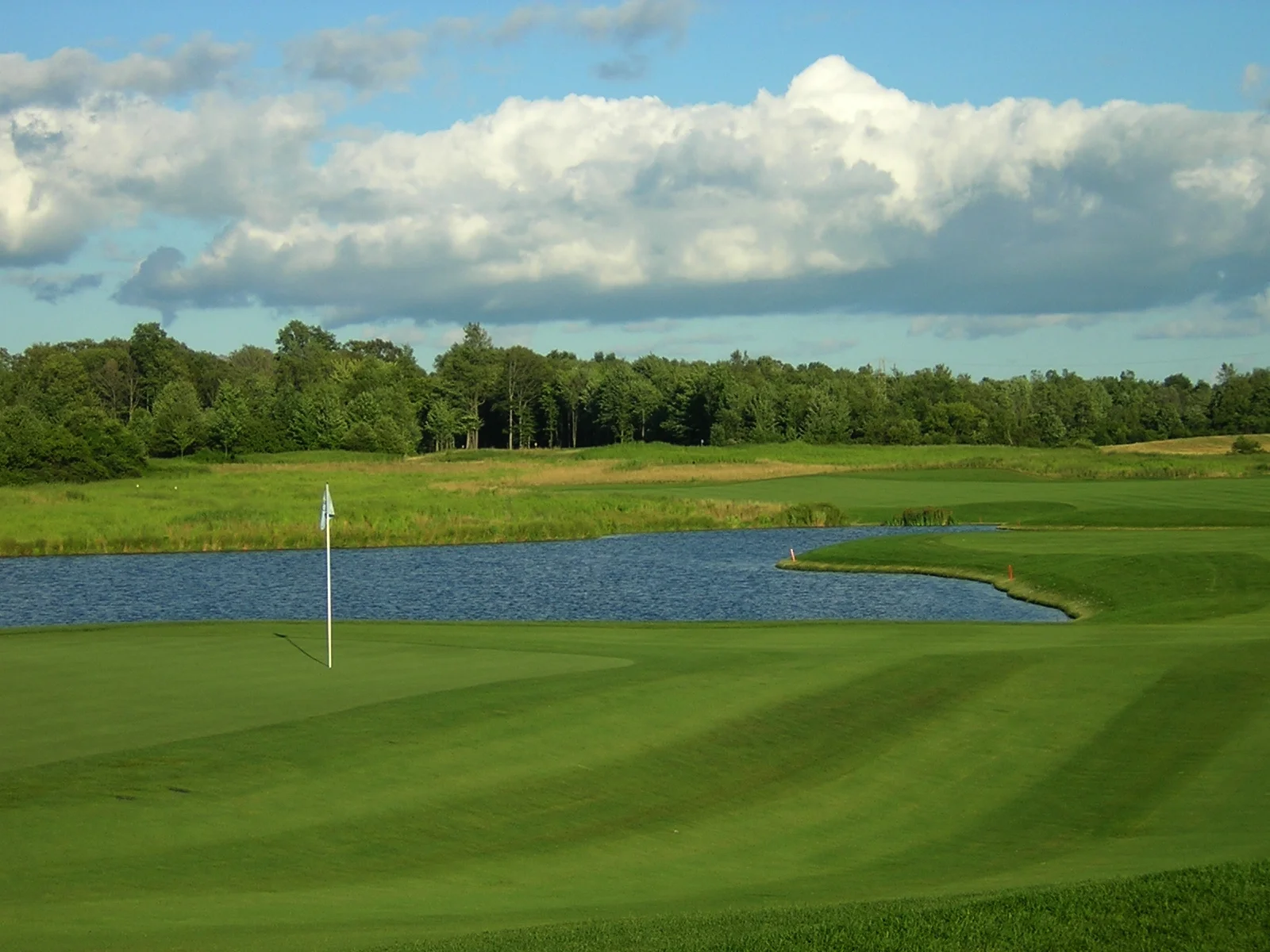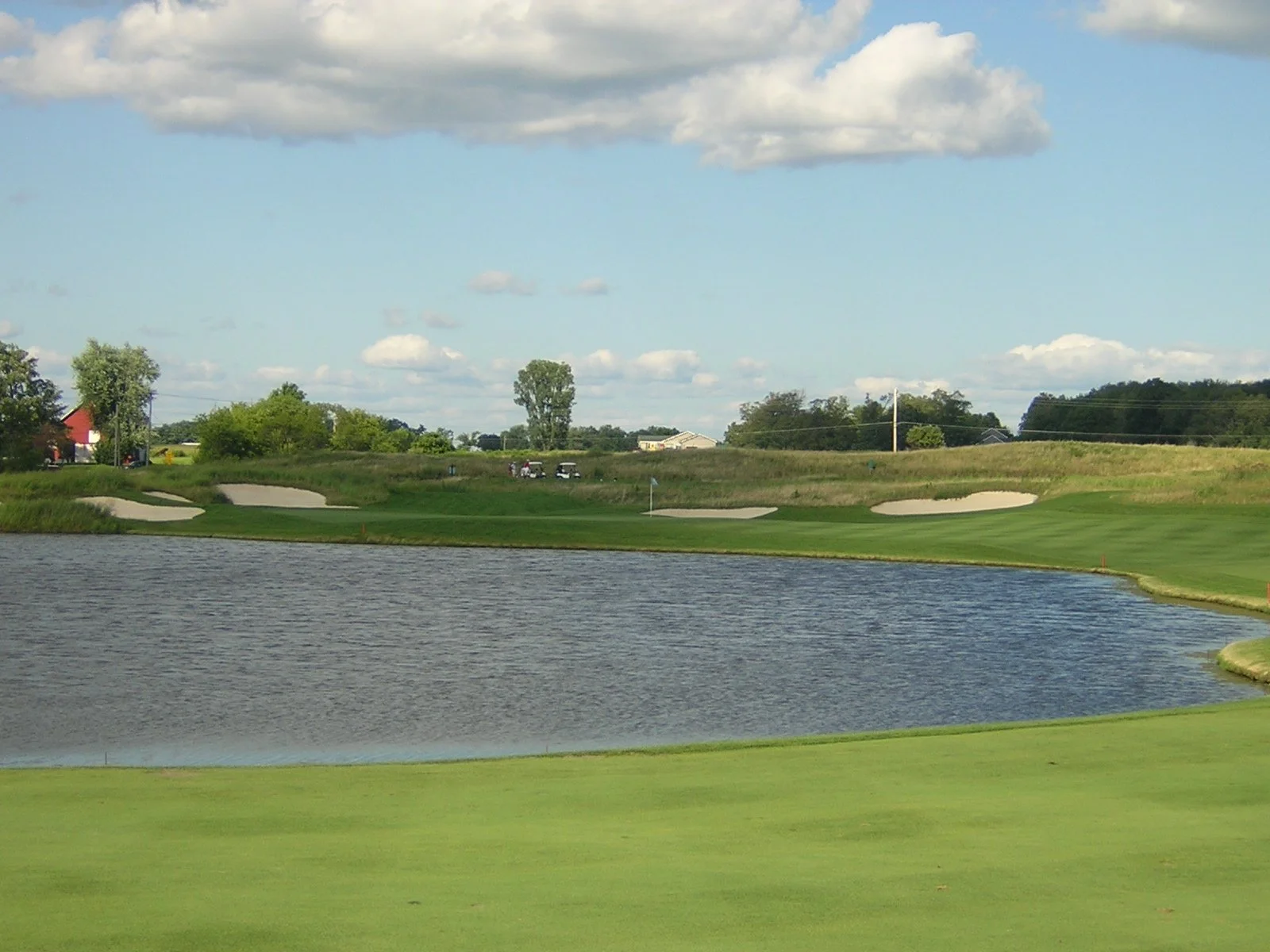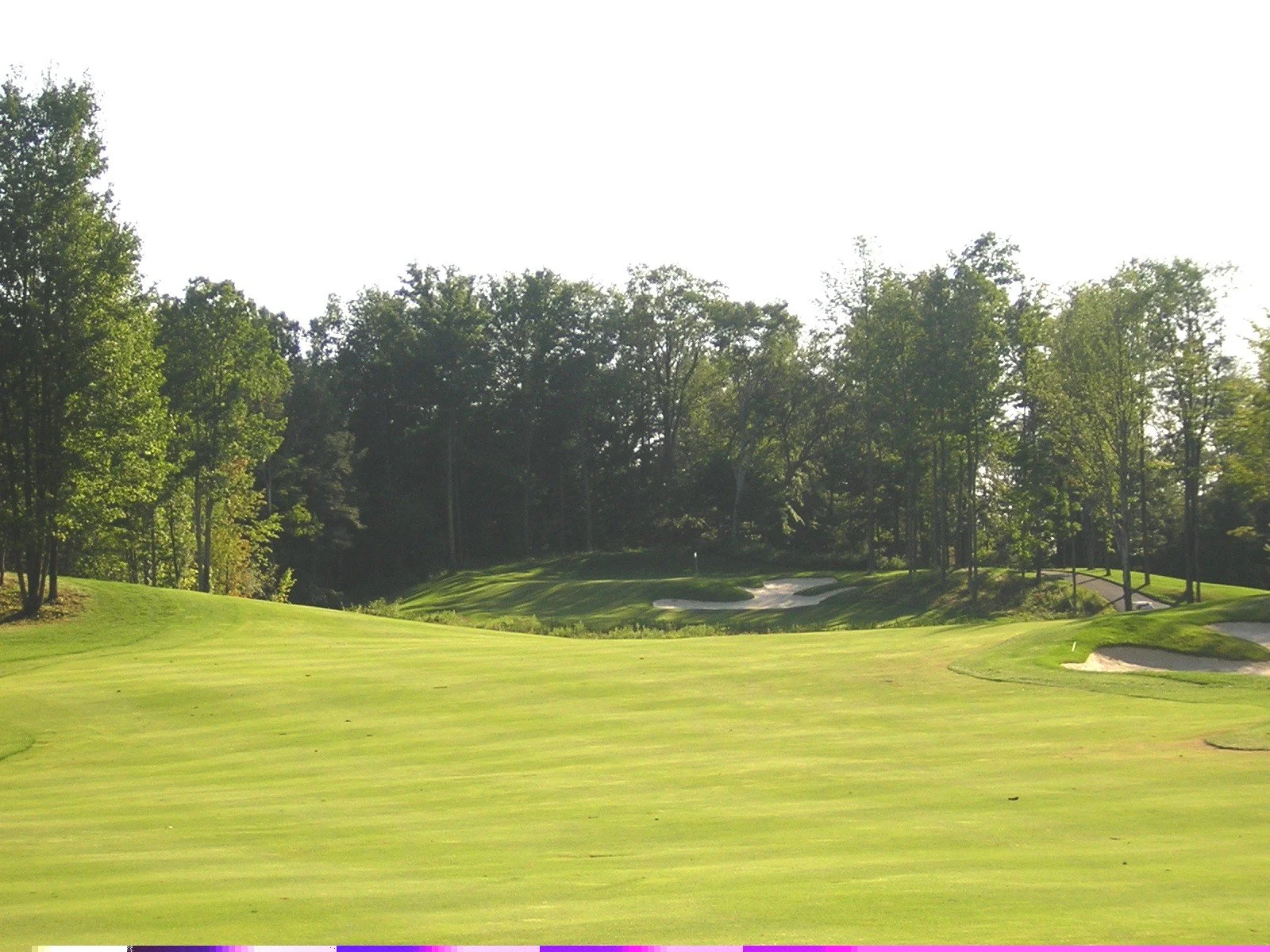KALUHYAT GOLF CLUB
Course Architect: Robert Trent Jones, Jr.
Year Opened: 2003
Location: Verona, New York
Slope: 146. Rating: 75.1
Par: 72
Yardage: 7,105
Hole-by-Hole: 1 - Par 5 530 Yds 10 - Par 4 385 Yds
2 - Par 4 406 Yds 11 - Par 5 621 Yds
3 - Par 4 420 Yds 12 - Par 4 427 Yds
4 - Par 4 357 Yds 13 - Par 5 558 Yds
5 - Par 3 155 Yds 14 - Par 4 395 Yds
6 - Par 5 554 Yds 15 - Par 3 172 Yds
7 - Par 4 449 Yds 16 - Par 4 431 Yds
8 - Par 3 218 Yds 17 - Par 3 175 Yds
9 - Par 4 451 Yds 18 - Par 4 401 Yds
Par 36 3,540 Yds Par 36 3,565 Yds
Awards Won: Top 10 public courses in New York - Golfweek (2006),
America's Best New Upscale Public Courses - Golf Digest (2005),
Rated #3 - Top 10 list of Best New Courses - Celebrated Living,
Top 10 New Courses You Can Play - Golf Magazine (2003),
Certified Signature Sanctuary designation - Audubon International.
Website: www.turning-stone.com
HISTORY: The second in the trilogy of world-class courses at Turning Stone Resort and Casino, Kaluhyat Golf Club, pronounced ga-LU-yut, is the Oneida Indian word meaning "the other side of the sky." Robert Trent Jones, Jr. got the call to design Kaluhyat, as he outdueled his brother Rees for the job.
Son of legendary architect Robert Trent Jones, Sr., Junior has a fantastic resume of his own. Poppy Hills Golf Course in Pebble Beach, Chateau Whistler in Canada, Poipu Bay Resort and the Prince Course in Kauai and the home of the 2010 Ryder Cup, Celtic Manor's Wentwood Hills Championship Course to name a few. RTJ2 has designed and worked on over 200 courses around the world, spanning 38 countries and six continents.
RTJ2 converted low-lying forest and farmland into a challenging and visually entertaining venue. His vision from day one has been to introduce new ideas for integrating golf with wetlands and other sensitive environments and creating playable golf courses rich with strategic variety. Only 4 to 4 1/2 hours from New York City and Philadelphia, Kaluhyat has all that and more.
It comes as no surprise that Kaluhyat was voted one of the best new upscale courses by Golf Digest and continues to reap the awards. Jones II loved the praise. "I'm glad that the major golf magazines, and others, are acknowledging the value of our efforts. I hope it will encourage people to come play Kaluhyat and enjoy what the course has to offer."
REVIEW: It's always nice to open a round of golf with a par five. It gives you chance to start with a birdie or a par, not to mention a hole where you can make a slight mistake and still come away unscathed. The first is just that, 530 yards from the black tees, bending to the right. The landing area is quite wide with a pair of traps down the right side, 255 to 315 yards out. The key is with your second shot. A massive trap, some 50 yards long stands short of the green, just 67 yards away. The object, either play left and leave yourself a simple wedge to the green, or go for it with 3-metal. The latter will need to split a pair of traps on either side of the green. The putting surface is quite long and undulating, with a ridge in the center, sloping from back to front. Stay below the hole for a birdie putt.
The view from the tee on the second hole is spectacular, as it sits well above the fairway. Just a 406-yard hole, this straightaway par four requires accuracy from the box, not length. Just a three-metal will set you up with a wedge to a long, narrow and slick green. A 35-yard long trap guards the right landing area, while rough and wetlands protect both sides of the hole through the green. The putting surface is very tricky, as any shot just off line on both sides will funnel down into chipping areas. The critical shot on this hole is your tee ball.
The third hole is a links-style setting, featuring native grasses and numerous sand traps. The fairway is inviting, however the key is to avoid the half dozen bunkers down the right side and one down the left side. The play is down the right, throwing caution to the wind and carrying the traps. This will set up a short iron to a wide, but narrow green. The putting surface features many
slopes with a fronting trap and one deep. A back-left pin can be quite difficult.
Short is not always the easiest, as is the case with the fourth. Just 357 yards from the tips, the fourth is the shortest par four on the course, but certainly not a pushover. Tree and marsh-lined from tee to green, the fairway is very tight with a pair of bunkers guarding the landing area on either side. A fairway metal should be the play off the tee, as this will set up a little wedge to one of the smallest greens on the course. Although a driver off the tee can get you close the promised land, the fairway runs out the deeper you go. The putting surface is well guarded with a 39-yard long bunker on the left and one trap deep.
The first par three is the shortest at just 155 yards long with 140 yards of that being carry over marsh and a pair of deep bunkers fronting the green. The putting surface is miniscule at just 24 paces deep with a hump in the center. The green slopes hard from left to right and is very slick. Making par here is an excellent score, despite having a short iron in your hands.
A very difficult par five, the sixth requires accuracy, length and brains. Start off with a big drive down the left side, avoiding the lake on the right. This will allow for an iron or hybrid for your next shot, as you traverse the wetlands that separate the fairway. Your second must be placed out towards the right side, as the hole dictates the angle. There are four strategically placed traps guard the left landing area, so stay clear. The approach to the green will be with just a wedge, however the green is just 29 paces deep, angled to the left, shaped like a "T" with two traps in the pits and slopes from back to front. Stay below the hole and you can make a simple birdie. Missing the fairway at any time on this hole will result in double-bogey or worse, so proceed cautiously.
Unless you hit your driver as far as Tiger Woods, you have nothing to fear on the seventh. A meaty par four of 449 yards and devoid of trees, this hole features a generous fairway and a decent size green. So where's the beef? Well, the tee shot must avoid the six large fairway bunkers down the right, not to mention the native grasses. A large lake from 145 yards in covers the left side and fronts the putting surface. The green is 37 yards deep with four traps behind the surface and to make matters worse, it's very undulating. Take your par or bogey and move on.
Continuing with the British Isles feel, the eighth is the longest par three on the course, stretching to a robust 218 yards from the black. Although the flag is in sight, the green is not, making club selection very difficult. The wind can really play havoc on this hole, so it's not uncommon to have a five-iron one day and fairway-metal the next. Just 26 paces deep, the putting surface is very wide and slopes from front to back with plenty of sand to catch errant shots.
If you thought the last couple of holes were difficult, you ain't seen nothing yet. Standing on the ninth tee, the furthest point from the clubhouse, the player has a couple of options. The hole features a split fairway as it bends to the right. Splitting the landing area is a pair of very deep traps, so one could play down the left to the wide fairway, but leaving a very long second. Or, bomb one down the right and avoiding eight, that's right, eight difficult bunkers. The problem is that this hole, like the last two, is wide open and the wind is usually in your face, so hitting a 270-yard tee shot is unlikely from the tips. A long-iron or fairway-metal will remain to the longest green on the course, some 44 yards in length with a pair of bunkers covering the left. The bail out area is to the right, but that's no bargain, as the rough is thick and penal. Here's an idea, play short of the green in two, chip within five feet and rely on your putter to make par.
Some seem to think that the 10th hole is one of the easiest on the course and on paper it might seem that way, but be careful. A slight dogleg to the left, this par four is short by today's standards at under 400 yards, but is tree-lined to the right and left and has a forced carry over wetlands. On the right side of the landing area is a deep, 40-yard long bunker and on the left another trap and tall trees guarding the dogleg. The play is to the right side of the fairway with a fairway-metal, leaving just a short-iron to a small target. The putting surface is elevated with two deep bunkers right and left. Any shot short of the target will roll down back into the fairway. A back-left pin could be a tough flag to get to.
Not only is the 11th the longest on the course, it is truly one of the most difficult driving holes at Kaluhyat. A massive 621 yards from the tips, a drive of some 230 yards is needed just to carry the wetlands and reach the fairway. Two traps guard the left side of the fairway as the hole doglegs to the left and trust me, they come into play. Trees flank both sides of the hole through the green, so there is no margin for error. Next up is the layup, which is a must, as there is no way of getting home in two. Reason one, more wetlands start at the 100-yard marker and number two, the green is elevated some 30 feet from the fairway. Take an extra club or two, depending upon the wind for your third. The green slopes hard from back to front with a trap guarding prior to the surface starting 32 yards out. This is the first of two of the hardest holes on the course, so be happy with par.
The No. 1 handicap hole, the 12th is pretty straightforward from an elevated tee box. Just rip it down the center of the tall, tree-lined fairway and you'll have a simple second. Easier said than done. A mid- to long-iron will remain to a green blanketed by sand. Five bunkers cover the left-front of the green and one deep-right will make your play uncomfortable. The right side of the putting surface is the play, however when the pin is back, you'll have to putt over a ridge to get to the flag. Oh, did I mention that the green is exposed to the elements, so an extra club or two will be needed.
A boomerang and a lake. That's what's in store on the par-five 13th. Measuring 558 yards from the tips, the hole is shaped like a crescent to the right featuring a lake on the right side from 300 yards in. The fairway is quite receptive off the tee, especially down the left, although three bunkers are in reach down that side. Once again, favor the left with your layup, as the water is very much in play. Your third shot, played with a little wedge, should be able to stick close to the flag, but don't get cute. Play left of the pin to take the water out of play. Any shot left of the green will collect in a chipping area, better there than wet.
The 14th is cut through the trees and doglegs hard to the right. A carry of 200 yards is required to reach the fairway, as you carry the wetlands. Two bunkers cover the left corner of the landing area and will see plenty of action, as players avoid the trouble on the right. The green is bunker-free, however a water hazard runs the gambit from 100 yards in on the right side. The putting surface is multi-tiered and set back in the trees. The green is very long and could require an extra club or two depending upon pin placement.
The first par three on the back nine, the 15th is a dandy and all carry over wetlands. To make matters worse, the green is only 19 paces long and very, very narrow. Talk about a small target with a mid-iron. Anything short and left is in the hazard, so bail right and rely on the short game.
Talk about a hard tee shot, the 16th is the most difficult on the course. First of all, the hole is 431 yards and plays downhill to the green. Second, the fairway narrows to just a few steps as the end of the fairway nears. So the problem is, that if you hit driver, then you must be straight, otherwise your shot will fall off the face of the earth into trees right and thick rough and native grasses left. Luckily, there are no fairway bunkers, but there is a cart path down the left that is in play. Your approach to the green is downhill to the putting surface, which sits precariously close to a pond on the right. Three bunkers protect the front and sides of this back to front, slick green. If you make par here, you're better than most.
The final par three, the 17th is similar in length to the 15th, but much different in appearance. The putting surface is very accessible with bunkers left and deep, however right of the green is trouble, as it falls off hard into deep rough. The green has a ridge running in the middle and with a back-right flag and a short approach, two-putting could be a chore.
The home hole is not the bear of a finisher that most courses conclude with, but it's certainly not to be taken for granted. The fairway off the tee is very generous, probably the widest on the course with only one fairway bunker, some 300 yards out. So green light with the driver. The key on 18 however is the second shot, as the putting surface is slightly elevated, two-tiered and bunker laden. A mid- to short-iron should be enough to negotiate the V-shaped green, but miss long and you'll have a difficult up and down for par.
OVERALL: As they say, "variety is the spice of life", and that is exactly what you get at Kaluhyat Golf Club. Tree-lined fairways, wide open spaces, beautiful bunkering, native grasses, undulating greens and dramatic elevation changes, is the norm at Kaluhyat. Did I forget to mention that this is one of the toughest golf courses in New York? How about a slope of 146 and a rating of 75.1! Only Bethpage Black is higher at 76.6.
Robert Trent Jones, Jr. has done a masterful job at creating a very unique golf course. The term "shot-maker's" course certainly comes to mind. Accuracy, length and most importantly, strategy are the keys to playing Kaluhyat.
Although there are many carries and plenty of water, the course is set up for all types of players and is quite fair. Five sets of tees range from 5,293 to 7,105 yards, so even the golfers at the red markers are not overly stressed.
From top to bottom this place is fantastic. The clubhouse, which is shared with the Shenandoah layout, is magnificent. The practice facility is top-notch and on your way to the first tee, so no back-tracking. The course conditioning is immaculate and the topography and design are first-rate.
I've said this before and I'll say it again, the Turning Stone Resort is a great golf destination, one in which I intend to visit yearly. Three great courses, hospitable staff, amazing food, incredible entertainment, a full-service spa and the Lodge, well pristine and stylish. I'll see you next year.












